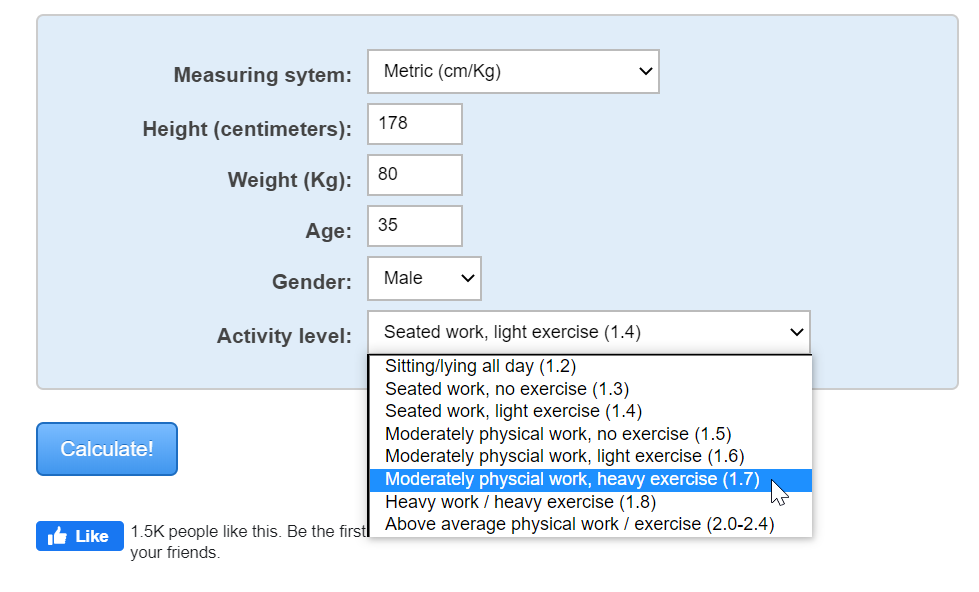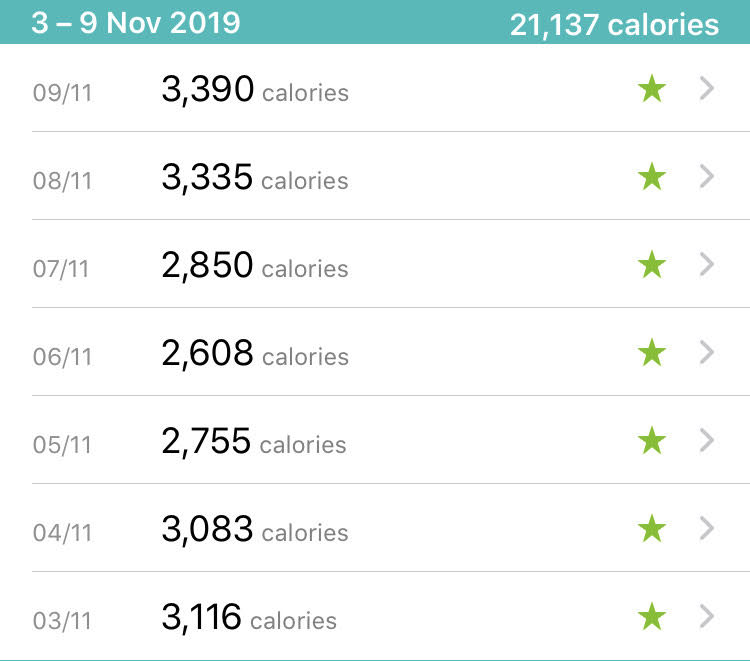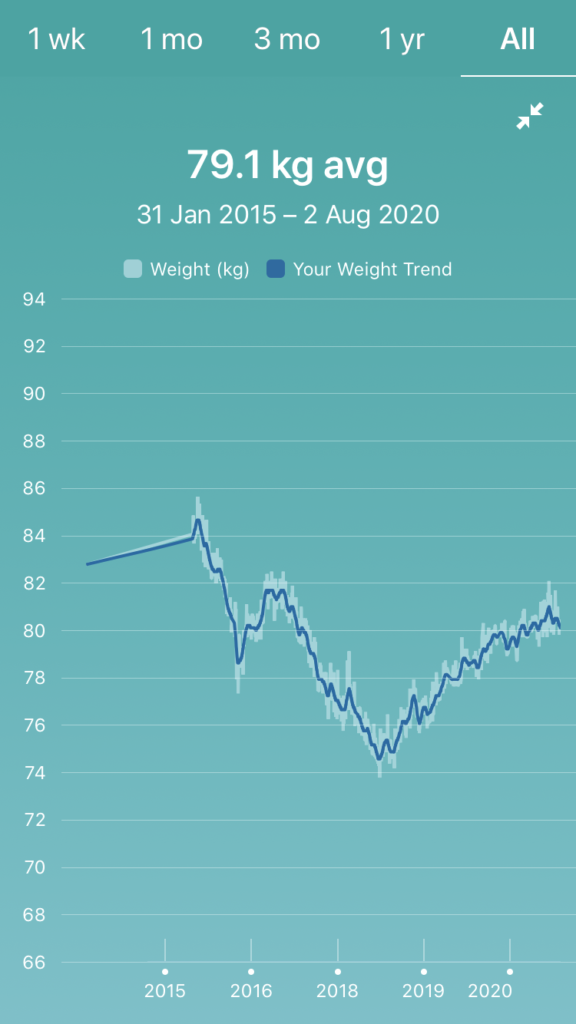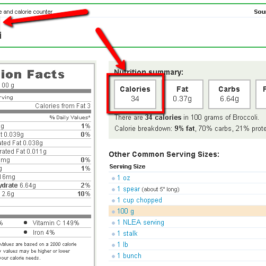- How Much Weight Can You Realistically Lose in 3 Months? - January 14, 2024
- How To Lose 1kg a Week (Guaranteed) - August 20, 2023
- How To Count Calories (or Estimate) and Stay on Track When Eating Out at Restaurants - July 25, 2023
HOW MANY CALORIES DO YOU NEED TO BURN TO LOSE 1KG (AND MORE)?
In order to lose 1kg (2.2lbs), you need to burn approximately 7,700 calories. For the vast majority of people, it is impractical to burn this amount of calories in less than 1 week. If you wanted to lose 1kg in a week, you’d need an average daily calorie deficit of 1,100 calories. That means, if your maintenance calories are 2,500, you’d need to eat 1,600 calories each day, on average.
TL;DR Track your calorie intake, calorie output, and weight every day so you know how many calories you need to lose weight.
Before I start, I’m going to assume that you want to lose fat rather than weight in general. Losing fat will make you look better, whereas losing weight (i.e. muscle and fat) will just make you look like a smaller version of yourself.
If you look like a bag of spanners now, and you lose muscle and fat, you’ll just end up looking like a smaller bag of spanners.
Trust me, you want to lose fat, not muscle.
The mechanism for losing fat and losing weight (fat and muscle) is actually the same, it’s just that you can take specific actions to mitigate any muscle loss throughout the process, assuming that you currently resistance train and eat enough protein to maintain your muscle mass these actions are;
At least maintain your current level volume load in your resistance training
At least maintain your current protein intake
The mechanism you need to exploit in order to lose fat, is calorie deficit (i.e. being a state where you burn more calories than you eat over a long enough period of time to lose the amount of fat you want).
HOW MANY CALORIES DO YOU NEED TO BURN TO LOSE A KILO?
It’s useful to know how much of a calorie deficit you need to create to lose 1kg.
1kg of fat contains 7,700 calories.
That means you need to burn 7,700 calories to lose 1kg of fat, aka, create a 7,700 calorie deficit over the period of time you want to lose that kilogram (be it a week, month, or longer).
In theory, you could do that in a day, if you did loads of walking and ate nothing, but that would NOT be a fun day.
A more sensible approach is to space those 7,700 calories out over a longer period of time to make the process of fat loss much more manageable.
The minimum amount of time I’d try to lose a Kilo in is one week, and in order to do this you’d need to create a 1,000 calorie deficit per day.
For anyone that prefers to use pounds (what’s wrong with you?), you’d need to create a deficit of 3,500 calories to lose one pound.
Before we go on, 1kg (2.2lbs for the yanks) might not sound like much but for most people, losing that amount of weight will make a big difference visually. This is what 1kg of fat looks like compared to 1kg of muscle.
GET TO THE POINT, HOW DO I WORK IT OUT?
First of all, you want to be clear about two things;
- The amount of fat you want to lose.
- When you want to lose it by
Let’s say you’re an 80kg male at 20% body fat.
That’s 16kg of fat you’re carrying around. Should you aim to lose all of it?
No, because you’d probably end up dying, which wouldn’t be great; after all what’s the point in being shredded if you can’t show off your abs because you’re dead?
A more sensible amount to lose would be half of that; 8kg.
That would leave you at 72kg with 8kg of body fat, putting you at a body fat level of 11%.
Assuming you’d taken all necessary measures to maintain your muscle mass, you should have kept it all, and with 8kg less body fat, you’d look pretty incredible in comparison.

Let’s say you have 6 months to lose that weight – it’s January now and you’re going to Ibiza with the ladz in June.
8kg in 6 months, easy (sort of).
Get Your Calculator Out
As we said, there are 7,700 calories in 1kg of fat, so in 8kg of fat there are 61,600 calories.
Sounds daunting, but remember, we have 6 months.
There are 30 days in a month (give or take), 6×30 is 180. So we have 180 days to spread those 61,600 calories over.
61,600/180 is 342.
Let’s call it 350 for the sake of simplicity
This means we need to eat 350 fewer calories per day than we are burning.
If you burn 2,500 calories per day on average, that means you need to eat 2,150 calories per day to lose 8kg of fat in 6 months.
Thanks for reading, k bye.
Joking. There are a couple more things we need to consider.
GET MY FREE 14-DAY FAT LOSS COURSE STRAIGHT INTO YOUR INBOX
HOW TO WORK OUT HOW MANY CALORIES YOU BURN ON A DAILY BASIS
The number of calories you burn on a daily basis is also known as your maintenance calories. I’ve made a whole guide on working out your maintenance calories here, but you can read how to do it below as well.
There are a ton of other resources out there on this topic, but when it boils down to it, you can use one of two methods
- Use a predefined online calculator
- Get an estimate from an activity tracker
It’s important to highlight that neither of these methods will give you a 100% accurate result, so it doesn’t really matter which one you pick, you just need a starting point.
I’ll show you how to use both.
Method 1: Use a Pre-Defined Calculator
There are many different calculators you can use to get an estimate of daily calorie burn. The most well-known one is arguably the Harris-Benedict equation.
Here’s a link to one https://manytools.org/handy/bmr-calculator/
This will spit out a number based on your height, weight, gender, age and activity level.
If you are going to use this method, it’s quite important to get the ‘activity level’ right

Although I have a sedentary job (sitting at a desk), I do around 10,000 steps per day, plus 4 weights sessions a week so I selected 1.7 (as you’ll see in a second from my actual Apple Health data, the result it gives me is probably quite accurate).
Here’s my results;

The BMR (base metabolic rate) is the number of calories you’d burn if you just laid there doing nothing all day (that sounds great doesn’t it). The ‘Daily Calorie Needs’ is your BMR plus the calories you burn on top of that from any physical activity.
If you can’t be bothered to click on that link, here’s another calorie calculator that you can use right now (in step 3 make sure you select ‘maintain weight’ to get your maintenance calories);
Calorie Calculator
Method 2: Get an Estimate From an Activity Tracker
The activity tracker I’m familiar with is FitBit, so I’m going to use that as an example.
Go to the calorie burn tab in FitBit and open it up so it shows your daily calorie burn.
Because it’s different every day, you’ll want to take an average – the longer time period you use to obtain that average the better, here I’m using 1 week.
FitBit will tell you your daily calorie burn.

To get the average just take the total and divide by the number of days (7 in this case).
21,137/7 = 3020
So FitBit is saying I’m burning 3020 calories per day on average (similar to the figure that the Harris-Benedict equation above gave me).
IS IT REALLY THAT SIMPLE?
Not quite.
The annoying thing about fat loss is that we can’t just stick to that initial calorie intake figure we calculated earlier (2,150 per day) and keep losing weight at the same rate.
The more fat you lose, the lower your daily calories will need to be in order to keep losing fat at the same rate until you hit your target weight.
The reason for this is that, as we get lighter, our BMR (Basal Metabolic Rate – the number of calories we’d burn if we just sat there all day doing nothing) reduces.
That’s right; contrary to what Sharon in accounts thinks – the lighter you are, the LOWER your metabolism (BMR) will be (generally speaking).
To illustrate this, let’s take a look at the differences in BMR for a range of different weights from 100kg-70kg
| Weight (Kg) | 100 | 95 | 90 | 85 | 80 | 75 | 70 |
| BMR (Calories) | 2095 | 2028 | 1961 | 1894 | 1827 | 1760 | 1693 |
This means that our typical male is burning 67 fewer calories at rest when he’s 75kg (just over halfway through his weight loss phase) than when he was 80kg.
67 calories really isn’t a huge amount but it’s worth being aware of.
So How Do We Get Around This?
Clearly, you don’t want to be doing a calorie output equation every time you lose half a kg, so the best way to stay on top of your calorie output is to track your weight every day.
This might sound like a ballache, but in reality, weighing yourself and noting it down takes about 10 seconds – a very small price to pay for something that will help keep you on track.
I’d weigh yourself first thing in the morning before you’ve eaten anything – do it at the same time every day so you get a consistent reading.
Each time you weigh yourself, keep a note of it.
You could just put it in your notepad app on your phone, or if you have a FitBit, stick it in the app – this is much better because it will plot a graph for you so so you see at a glance if you’re going in the right direction.
AND WHAT CALORIE DEFICIT IS REQUIRED TO LOSE 1KG?
Well, that depends how quickly you want to lose 1kg.
If you wanted to lose 1kg in a week then you’d need a deficit of 1,000 calories day. That means if you used 2,500 in a typical day, you’d need to eat 1,500 every day for a week to drop 1kg.
It’s quite a big ask, but certainly doable.
If you wanted to make it much easier, you could give yourself a longer timeline, for example if you were happy to drop a kilo in 2 weeks, then you’d only need a deficit of 500 calories a day.
HOW TO MONITOR YOUR PROGRESS
Although you DO want to weigh yourself every day, you don’t want to agonise over a single weigh-in.
Your weight WILL fluctuate on a daily basis for a variety of different reasons, so it’s better to look at your weight at the end of each week.

Above is my weight over the past few years, as you can see it jumps around all the time, but over longer periods of time, it’s going the directions I want (whether that’s up or down).
Using the example above again, if we’re aiming to lose 8kg in 6 months, that’s 1.3kg per month or 0.3kg per week.
The other important thing to remember (and as the graph above shows) is that it’s highly unlikely your weight loss will be linear, i.e. our example probably wouldn’t lose exactly 1.3kg per month, it may be 2kg in month 1, 1kg in month 2, etc, etc.
You NEED to be aware that weight loss takes time, and no weight loss journey will ever go 100% to plan. For this reason, if you are working to a time limit, always give yourself an extra few weeks of contingency. Also be aware that a calorie deficit takes time to start working, so be patient, and don’t expect Kgs of weight loss in the first few weeks.
The good news is that weighing yourself daily keeps you accountable and cuts out any anxiety around not losing the weight in time because you know exactly where you are at any one time and can make adjustments based on your rate of weight loss.
Not losing weight quick enough? Fine, try dropping calories by 10%.
Losing weight too quickly? Great, keep going or back off a little.
Hell, even if you don’t quite hit your target and you only lose 5kg of fat, that would put you at 75kg and 15% body fat, still looking way better than you did before.
RECAP
Let’s go over the steps one more time;
- Work out how much weight, you want to lose, and how quickly you have to lose it. This will give you your calorie deficit figure
- Work out how many calories you’re burning each day on average using either an equation or actual data from your activity tracker
- Subtract the figure from step one from the figure from step 2. That’s how many calories you should aim to eat on average per day to reach your target weight.
OR just use the calculator in this post.
4. Monitor your weight daily to make sure you’re on track. If not adjust your calories or activity accordingly
That sounds really simple, and the maths bit is. Anyone can work all of that out in a couple of minutes.
The difficult part is sticking to that calorie target every day, consistently, and without being overcome by hunger and saying no to drinking sessions or cheeky Nandos.
If you want help with that, get in touch.







Leave a Reply